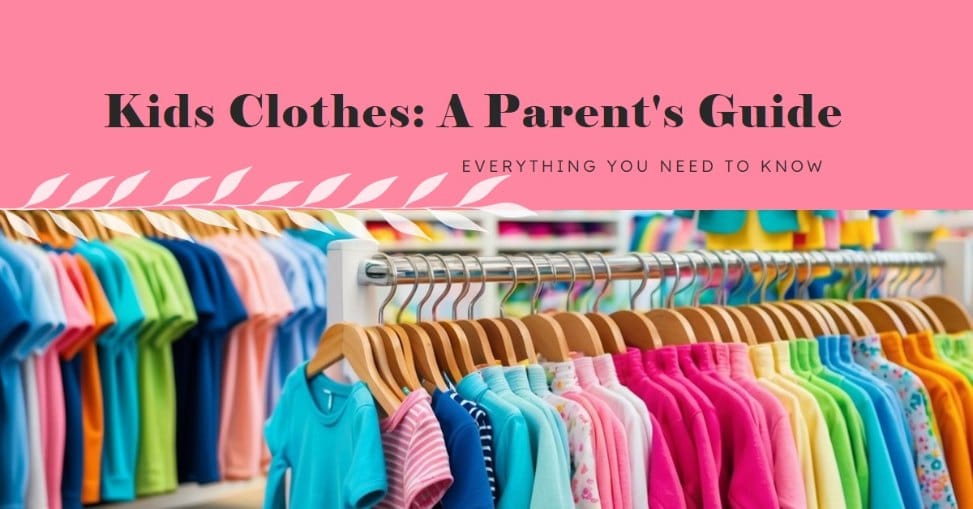Kids clothes are more than just mini versions of adult fashion. They’re a world of fun, comfort, and practicality all rolled into one. From everyday basics to special occasion outfits, children’s clothing offers a wide range of options to suit every need and personality.
Choosing the right clothes for children involves considering factors like durability, ease of care, and age-appropriate styles. Parents and carers often look for items that can withstand active play, frequent washing, and quick growth spurts. Many brands now offer clothing lines designed specifically for kids, with features like adjustable waistbands, reinforced knees, and easy-to-fasten closures.
Today’s childrenswear market caters to diverse tastes and needs. You’ll find everything from cosy pyjamas and school uniforms to trendy outfits and eco-friendly options. Many shops also stock clothing for children with special needs, ensuring comfort and style for every child.
On This Page
Key Takeaways
- Kids clothes blend comfort, durability, and style to meet children’s active lifestyles
- The childrenswear market offers a wide range of options for everyday wear and special occasions
- Many brands now focus on eco-friendly materials and inclusive designs for children of all abilities
Understanding Childrenswear
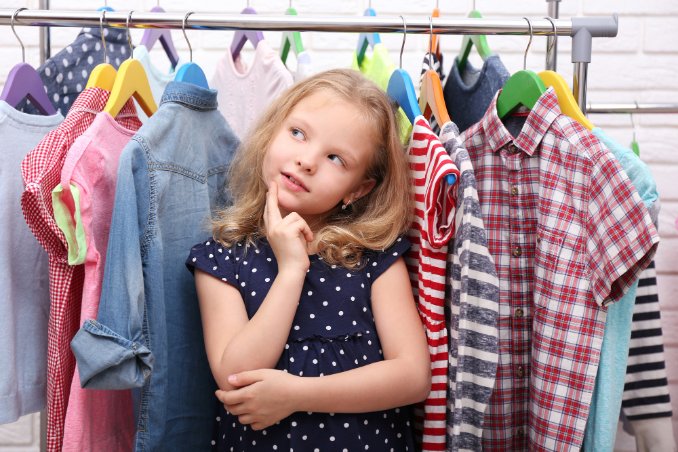
Childrenswear encompasses a wide range of styles, materials, and sizing considerations. It blends fashion with practicality to meet the unique needs of growing children.
Styles and Trends
Kids clothing styles vary greatly, from casual playwear to formal outfits. Popular trends include mini-me looks that mimic adult fashion. Graphic tees with fun prints and slogans are a staple. Denim remains a classic choice for jeans and jackets.
For girls, dresses and skirts in bright colours and patterns are common. Boys’ styles often feature cargo shorts and sporty tops. Unisex clothing is gaining popularity, with neutral colours and simple designs.
Seasonal trends play a big role in childrenswear. Winter brings cosy jumpers and warm coats, while summer calls for light sundresses and shorts.
Check out our stylish and trendy girl’s clothing to wear to different occasion
Material Considerations
The choice of fabric is crucial in kids clothes. Comfort and durability are key factors. Cotton is a popular choice due to its softness and breathability.
Organic cotton is becoming more common as parents seek eco-friendly options. It’s grown without harmful pesticides, making it gentler on sensitive skin.
Synthetic materials like polyester are often used for sportswear due to their moisture-wicking properties. Wool and fleece are favoured for cold-weather gear.
Easy-care fabrics that resist stains and wrinkles are a hit with busy parents. Many brands now offer clothes made from recycled materials to appeal to eco-conscious families.
Sizing and Fit
Children’s clothing sizes can be tricky as kids grow quickly. Most brands use age-based sizing, but it’s not always accurate. Some offer height-based options for a better fit.
Adjustable features like elastic waistbands and roll-up cuffs help extend wear time. Many parents buy clothes a bit larger to allow room for growth.
Fit is important for comfort and movement. Clothes should not be too tight or restrictive. For babies and toddlers, easy-change designs with snap fasteners are useful.
Some brands now offer adaptive clothing for children with special needs, featuring easy-on designs and sensory-friendly fabrics.
Everyday Wear Essentials
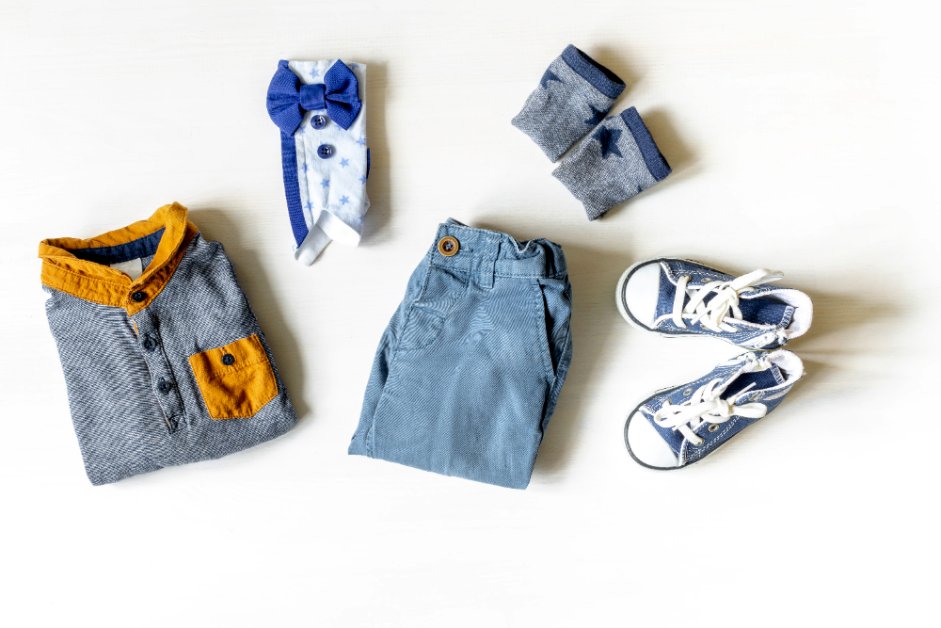
Kids need comfy clothes for daily activities. A good mix of bottoms and tops lets them play and learn with ease. Here are the key items for a child’s everyday wardrobe:
Trousers and Joggers
Trousers and joggers are must-haves for kids. Jeans are tough and can handle rough play. Look for styles with knee patches for extra strength. Joggers offer more stretch for active kids. They’re great for sports or lazy days at home.
Leggings are comfy options for girls. They work well under dresses or on their own. Choose thick, soft fabrics that won’t wear out fast. Aim for 3-4 pairs of each type of bottom. This gives enough options for a week of wear.
For cooler days, fleece-lined trousers or joggers keep little legs warm. Make sure to pick sizes with room to grow, as kids can shoot up quickly.
T-Shirts and Tops
T-shirts form the base of a child’s wardrobe. Stock up on plain tees in various colours. These can be mixed and matched with any bottom. Look for soft, breathable fabrics like cotton.
Long-sleeved tops are good for layering. They work well under jumpers or on their own. Aim for 5-6 tops in total. This gives enough choice without too much clutter.
For girls, a few pretty blouses can dress up an outfit. Boys might like polo shirts for a smart-casual look. Don’t forget vests or tank tops for hot days or for layering in winter.
Opt for easy-care fabrics that can handle frequent washing. Avoid tops with fussy details that might annoy active kids.
Skirts and Shorts
Skirts and shorts are perfect for warmer days. Girls might like a mix of styles – from twirly skirts to sporty skorts. Shorts work for both boys and girls. Denim shorts are tough and versatile.
Aim for 2-3 pairs of shorts and 2-3 skirts. This gives enough options without overloading the wardrobe. Choose items that can be dressed up or down.
Look for skirts with built-in shorts for active girls. For boys, cargo shorts with pockets are handy for collecting treasures. Make sure waistbands are comfy and easy for kids to manage.
Jumpers and Cardigans
Jumpers and cardigans are key for layering. A zip-up hoodie is great for quick warmth. Crew neck jumpers work well over collared shirts for a smarter look.
Cardigans are handy for girls to throw over dresses. Choose neutral colours that go with lots of outfits. Aim for 2-3 warm layers in total.
Look for easy-care fabrics that can handle being tossed in a school bag. Avoid wool unless it’s machine washable. Fleece is a good option – it’s warm, soft, and easy to clean.
Special Occasion Outfits
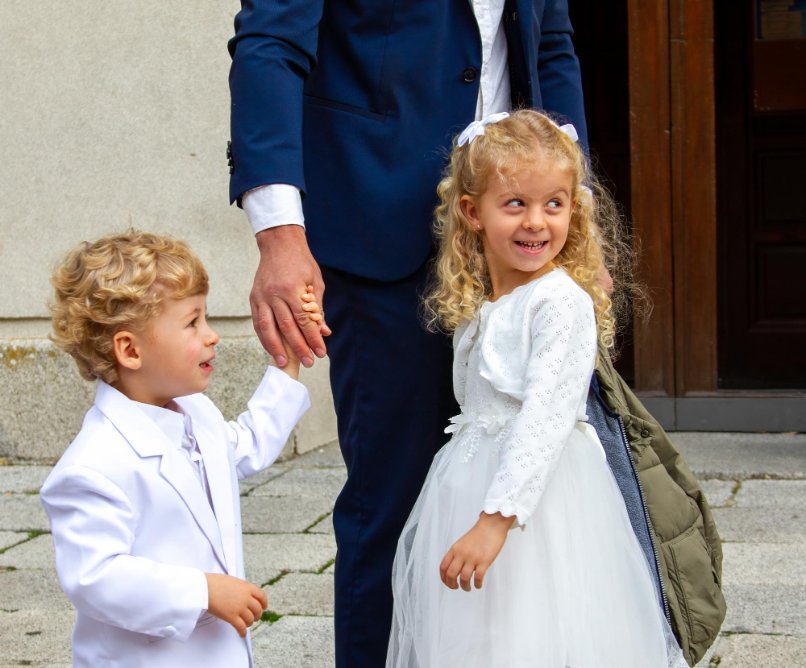
Kids need smart clothes for important events like weddings, parties, and holidays. The right outfit helps them look their best and feel special.
Dresses and Rompers
Dresses are a top choice for girls’ special occasions. Fancy frocks often have lace, ruffles, or sparkly details. Colours range from soft pastels to bold shades. For younger girls, rompers offer a cute and comfy option.
Some popular styles include:
- Tulle skirts with sequin tops
- Floral print cotton dresses
- Velvet party dresses
- Satin bow-back dresses
Many brands make matching shoes and accessories. Hair bows, tights, and small bags complete the look. For cooler weather, add a smart cardigan or coat.
Suits and Formal Wear
Boys can look dapper in suits or smart separates. A classic white shirt paired with dress trousers is always stylish. Add a tie or bow tie for extra flair.
Key pieces for boys include:
- Navy or grey suit jackets
- Dress shirts in white or pale colours
- Smart trousers or chinos
- Waistcoats for a more formal look
Blazers work well for less formal events. They can be paired with smart jeans for a trendy outfit. Don’t forget shiny dress shoes to finish the look.
For both boys and girls, comfort is key. Choose fabrics that are soft and easy to move in. This helps kids enjoy the event without fussing over their clothes.
Nightwear and Loungewear
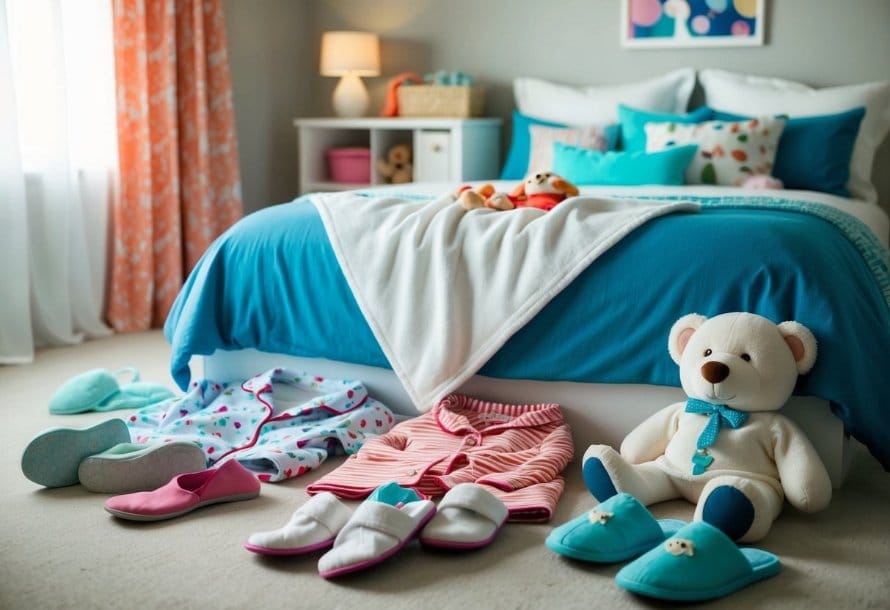
Kids need comfy clothes for bedtime and relaxing at home. Pyjamas, nightgowns, and loungewear sets are key items for a child’s wardrobe.
Pyjamas and Nightgowns
Pyjamas come in various styles for boys and girls. Cotton is a popular fabric choice for its breathability and softness. Many sets feature fun designs with cartoon characters or animals. Long-sleeved tops with matching bottoms are great for cooler months. In summer, short-sleeved or sleeveless options keep kids cool.
Nightgowns are a comfy choice for girls. They often have pretty patterns or frilly details. Some nightgowns have built-in shorts underneath for extra coverage.
For both pyjamas and nightgowns, look for:
- Soft, stretchy fabrics
- Easy-to-use fastenings
- Non-slip soles on footed styles
Loungewear Sets
Loungewear is perfect for lazy days at home. These comfy outfits blend style and cosiness. Many sets include a top and bottom that can be worn together or mixed with other clothes.
Popular loungewear items for kids:
- Soft sweatpants
- Hooded tops
- Fleece jackets
Some sets have matching slippers to complete the look. Brands often use fun prints or bright colours to appeal to kids.
When choosing loungewear, think about:
- Durable fabrics that can handle playtime
- Roomy cuts for easy movement
- Pockets for storing small treasures
Outerwear and Seasonal Clothing
Kids need proper outerwear to stay warm and dry in different weather conditions. The right clothing helps children enjoy outdoor activities year-round.
Coats and Jackets
Warm coats are essential for cold weather. Padded jackets with down or synthetic filling provide excellent insulation. Waterproof rain jackets keep kids dry on wet days.
Look for coats with features like:
- Hoods to protect from wind and rain
- Adjustable cuffs to keep out cold air
- Reflective details for visibility in low light
- Multiple pockets for storing small items
Layering is key for changing temperatures. A fleece jacket works well as a mid-layer under a heavier coat. For milder days, a lightweight windbreaker offers protection from breezes.
Cold-Weather Accessories
The right accessories help kids stay cosy in chilly weather. Warm hats prevent heat loss through the head. Scarves protect the neck and can be tucked into coat collars.
Gloves or mittens are a must for cold hands. Mittens tend to be warmer, while gloves allow more finger movement. Look for waterproof options for snow play.
Thick socks keep feet toasty in boots. Thermal underwear adds an extra layer of warmth under regular clothes on very cold days.
For rainy weather, wellies and waterproof trousers help kids splash in puddles without getting soaked.
Themed and Character Clothing
Kids love clothes that show off their favourite characters and interests. These fun outfits let children express themselves and feel connected to stories they enjoy.
Character Shop
Character shops offer a wide range of clothing featuring popular TV, movie, and book characters. T-shirts, pyjamas, and accessories with beloved characters like Peppa Pig, PAW Patrol, and Disney princesses are big hits. Many shops stock over 200 different character options.
Kids can find comfy onesies, nightdresses, and swimwear with their top picks. Backpacks and hats let them carry their favourite characters to school. Some shops even have adult sizes for parents who want to match.
High-quality materials ensure the clothes are soft and long-lasting. Free delivery is often available on larger orders. Many character shops offer easy returns if items don’t fit.
Interest-Based Collections
Beyond specific characters, kids clothing lines cater to broader interests. Unicorn and floral prints are popular choices for girls who love fantasy and nature themes. Harry Potter fans can find Hogwarts house-themed outfits and accessories.
Space-themed clothes with rockets and planets appeal to budding scientists. Animal prints like dinosaurs or sharks are perfect for wildlife lovers. Some shops group clothes by interests like sports, music, or art.
These collections let kids show off their hobbies and passions. They’re great for finding gifts that match a child’s personality. Many interest-based clothes use bright colours and fun designs to catch kids’ eyes.
Eco-Friendly and Sustainable Options
Many parents are looking for eco-friendly kids clothing options. Several brands now offer sustainable choices that are good for the planet and durable for active children.
Organic cotton is a popular material for sustainable kids’ clothes. It’s grown without harmful pesticides and uses less water than conventional cotton. Brands like Hanna Andersson have been using organic cotton since the 1990s.
Some companies focus on creating long-lasting garments. Firebirds makes zero-waste kids fashion designed to be handed down through generations. They use certified organic materials and produce clothes in small batches to reduce waste.
Patagonia is known for high-quality outdoor gear and clothing for kids. They prioritise sustainability in their manufacturing processes and offer repair services to extend the life of their products.
Many sustainable brands use recycled materials in their clothes. This helps reduce waste and gives new life to existing fabrics. Some also have take-back programmes where parents can return outgrown clothes for store credit.
When shopping for eco-friendly kids clothes, look for:
- Organic or recycled materials
- Durable construction
- Low-impact dyes
- Fair labour practices
- Take-back or recycling programmes
By choosing sustainable options, parents can dress their children in stylish, comfortable clothes while reducing environmental impact.
Choosing The Right Accessories
Accessories can make or break a child’s outfit. The right choices add flair and function to kids clothes. Let’s look at key types of accessories for children.
Functional and Stylish Accessories
Hats protect kids from sun and cold while adding style. Baseball caps work for casual looks. Beanies keep heads warm in winter. For girls, headbands and hair clips tame flyaways and dress up outfits.
Belts help trousers fit better on growing bodies. Pick adjustable styles that last longer. Suspenders offer a fun alternative for special occasions.
Bags let kids carry their own gear. Backpacks work for school. Small crossbody bags suit outings. Choose sturdy materials that withstand rough play.
Watches teach time-telling skills. Pick easy-to-read faces with comfy straps. Water-resistant models stand up to splashes.
Shoes and Footwear
Proper shoes support growing feet. Measure size often, as kids’ feet grow fast. Leave room for toes to wiggle.
Trainers suit most daily activities. Look for flexible soles and breathable uppers. Velcro closures help young kids dress themselves.
Wellies keep feet dry in wet weather. Choose lined styles for warmth. Slip-resistant soles prevent falls on slick surfaces.
Dress shoes complete fancy outfits. Mary Janes work for girls. Boys can wear loafers or lace-ups. Ensure a snug fit to avoid blisters.
Sandals cool feet in summer. Pick styles with ankle straps for security. Closed toes protect from stubbed toes during play.
Frequently Asked Questions
Why is children’s clothing important?
Children’s clothing is essential for comfort, protection, and self-expression. Proper clothing shields kids from weather conditions, while comfortable fabrics prevent skin irritation. As they grow, clothing also becomes a way for them to express individuality and develop confidence.
How to choose dress for kids?
When choosing a dress for kids, consider:
1. Comfort: Soft, breathable fabrics like cotton.
2. Fit: Opt for a dress with a little room for movement and growth.
3. Occasion: Casual for everyday wear, fancier for events.
4. Practicality: Dresses with easy closures, like buttons or zippers, make dressing easier.
Do kids clothes go by age?
Yes, many brands size kids’ clothes by age, but it’s not always accurate since children grow at different rates. Always check the brand’s size chart, and if possible, try clothes on or measure your child for a better fit.
How many clothes does a child really need?
The number of clothes a child needs depends on age, lifestyle, and how often you do laundry. For an average child:
• 7-10 tops
• 5-7 bottoms
• 2-3 jackets or hoodies
• 3-4 pyjamas
• 7-10 pairs of socks and underwear
It’s best to have a few extra items to account for spills and growth spurts.
Why are kids picky about clothes?
Kids can be picky about clothes due to:
1. Sensory sensitivity: Fabrics that itch or feel rough.
2. Personal preferences: Favourite colours or characters.
3. Temperature: Some kids run hot or cold and prefer certain clothes based on how they feel.
4. Development of independence: As kids grow, they begin making their own choices and may resist wearing items they don’t like.
How many pyjamas should kids have?
Kids should have around 3-4 sets of pyjamas. This allows for washing cycles and gives room for variety, especially if they tend to get pyjamas dirty or wear them during the day as well.
How often should you buy kids clothes?
You’ll likely need to buy new clothes for your child every 6-12 months, depending on how fast they grow and the season. Keep an eye on sales for essential items and size up when buying seasonal clothes to last longer.
How often do kids grow out of clothes?
Most children outgrow their clothes every 6 months when they’re toddlers, but growth may slow down as they age. Once they hit school age, you might find they need new clothes once or twice a year.
At what age should a child pick out their own clothes?
Children as young as 2-3 years old start expressing preferences for what they wear, but by 4-5 years old, many kids can pick out their own outfits. Encouraging this independence is a great way to boost their confidence.
Is it better to size up kids clothes?
Yes, it’s often better to size up, especially for tops and jackets, since kids grow quickly. For trousers, you can size up and use adjustable waistbands or roll the cuffs. It helps stretch the lifespan of the clothes.
At what age do kids start caring about their clothes?
Most kids start caring about their clothes between age 4-7. This is when they begin to notice what their peers are wearing, develop a sense of style, and may ask for specific clothes or styles.
What are 4 guidelines for choosing children’s clothing?
1. Comfort: Soft, breathable fabrics that won’t irritate sensitive skin.
2. Durability: Clothes that can withstand frequent washing and play.
3. Safety: Avoid small buttons or accessories that could be choking hazards.
4. Practicality: Easy to wear, take off, and clean, with some room for growth.
What age do kids want to dress themselves?
By age 2-3, many kids start wanting to dress themselves, though they may need help with fasteners like buttons and zippers. By age 4-5, most children can dress themselves with minimal assistance.
Should I tell my daughter how to dress?
It’s good to guide your daughter when needed, especially regarding weather-appropriate or occasion-specific outfits, but allowing her to make her own choices fosters independence and self-expression. Suggest options, but let her have the final say when possible.
Is it better to hang or fold kids clothes?
It depends on the item:
• Hang: Dresses, jackets, shirts.
• Fold: T-shirts, trousers, pyjamas.
Folding saves space, while hanging helps avoid wrinkles in certain items.
What size do most 7-year-olds wear?
Most 7-year-olds typically wear size 7-8, but this can vary depending on their height and build. Always refer to the brand’s sizing chart, and when in doubt, size up to give them room to grow.

